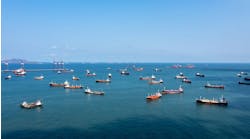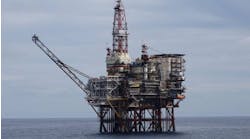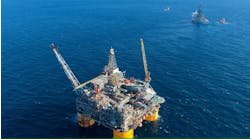Jeremy Beckman • London
North America
Talos Energy aims to start appraisal drilling late this year on its shallow-water Zama oil discovery in block 7 offshore Mexico. This will comprise back-to-back wells and a side track to confirm the oil-water contact and to better define distribution of the reservoir. Pemex is also negotiating for a rig for the Asab-1 well to test an extension of Zama into an adjacent block.
Sea Swift platform at the Iguana field offshore Trinidad. (Courtesy Aquaterra Energy)
Caribbean Sea
Aquaterra Energy has delivered a conductor-supported Sea Swift platform to the Iguana field in the Gulf of Paria offshore Trinidad and Tobago for DeNovo Energy. The structure, built by Chet Morrison Contractors, was installed from a jackup in 27 m (89 ft) water depth. It can accommodate up to four wells and includes power generation, manifolds and control systems.
•••
Guyana’s government has approved Hess’ acquisition of a 15% interest from ExxonMobil in the Kaietur block, 155 mi (250 km) offshore and adjacent to the Stabroek block where the two companies are already partners. This year they plan to process and interpret 5,700 sq km (2,201 sq mi) of 3D seismic data for assessment of future drilling opportunities.
Brazil
Petrobras has started production from the Búzios field in the presalt Santos basin via the FPSOP-74. The facility is stationed 200 km (124 mi) offshore Rio de Janeiro state in 2,000 m (6,562 ft) water depth. Four more platforms are due to be added to the field by 2021, each capable of processing up to 150,000 b/d of oil and 6 MMcm/d of gas.
The company has also signed a memorandum of understanding with BP to jointly explore business opportunities in Brazil and elsewhere, including in the upstream sector. They currently have joint interests in 16 exploration blocks in Brazil.
•••
QGEP Participacoes has delivered first oil from an early production system at the Atlanta field in block BS-4 in the Santos basin. The FPSO Petrojarl 1, turret-moored in 1,550 m (5,085 ft) of water, will eventually be connected to four wells with horizontal wet Christmas trees: once the third well is onstream, production should build to 30,000 b/d. A fuller-scale development should follow in 2021 featuring a larger FPSO with 80,000 b/d process capacity.
West Africa
TechnipFMC is conducting front-end engineering design (FEED) for the FPSO for phase 1A of BP’s ultra-deepwater Tortue/Ahmeyim LNG project on the maritime border of Mauritania and Senegal. The program involves defining the technology and equipment scope, and could be converted later to a full EPCI award.
Initial subsea facilities will connect the first four wells through production flowlines to the FPSO, where the liquids will be extracted and the gas exported through a pipeline to a floating LNG hub terminal for liquefaction. Golar LNG is set to perform FEED for the FLNG vessel which would be converted at Keppel Shipyard in Singapore.
•••
Australian independent FAR has contracted the deepwater drillshipStena DrillMAX for a well later this year on the potential 825-MMbbl Samo prospect in block 2 off The Gambia. This will be the country’s first offshore well for over 40 years: FAR believes Samo shares characteristics with the deepwater SNE oilfield to the north off Senegal.
•••
Crane lift operations onto Egina FPSO. (Courtesy ALE)
ALE has claimed a record lift for a land-based crane with a jib, while lifting the S2 topsides module onto the deck of Total’s Egina FPSO at a yard in Lagos. The crane was rigged with a 124-m (407-ft) A-frame main boom, a 49-m (1610-ft) ballast radius, and a 38-m (125-ft) jib for extra outreach, supported by a heavy winch system and 4,000 tons of ballast. ALE lifted a total of six topsides modules ranging in weight from 335 tons to nearly 3,000 tons.
•••
Noble Energy has signed a Heads of Agreement with Equatorial Guinea’s government concerning commercialization of gas from the Alen field in offshore blocks O and I: to date the gas has been re-injected into the reservoir to enhance liquids recovery. The parties plan to construct a 65-km (40-mi) subsea pipeline transporting the gas to LPG and LNG plants at the Punta Europa complex on Bioko Island. The Alen platform would also serve in future as a hub for development of other nearby stranded offshore gas fields.
•••
Eni’s recently onstream Ochigufu field in block 15/06 off Angola has attained plateau output of 24,000 b/d, lifting production from the block above 150,000 b/d. The field, in 1,300 m (4,265 ft) water depth, 150 km (93 mi) west of Soyo, is connected via the Sango production system to the block’s West Hub FPSON’Goma. Eni’s goal is to boost production by a further 54,000 b/d by next year.
•••
Namibia’s government has awarded Calima Energy operatorship of offshore block 2813B in the Orange River basin. Initial plans call for acquisition of 2D or 3D seismic and a review of prospectivity. Shell reportedly plans to drill two exploration wells on acreage to the southeast.
Eastern Europe
Allseas will begin laying the Balticconnector gasline in the Baltic Sea between Finland and Estonia during summer 2019, a program largely funded by the European Union. Finnish Diving Support was recently due to clear explosives close to the planned route in the Gulf of Finland.
In the Black Sea, Allseas’Pioneering Spirit has completed deepwater pipelay for the first of the twin TurkStream offshore gas lines for operator Gazprom, and the vessel is due to continue work on Line 2 this summer.
Caspian Sea
Lukoil has installed the topsides of a new wellhead platform for the Yuri Korchagin Phase 2 development in the Russian sector of the Caspian Sea. This is a satellite platform on the eastern part of the field. The company has further plans to develop the Rakushechnoye oil and gas field in this sector, via an ice-resistant fixed platform, living quarter platform and three subsea pipelines, according to the Russian Maritime Register of Shipping. Facilities will be connected to the pipeline and power supply systems currently serving both Yuri Korchagin and the Vladimir Filanovsky field.
•••
SOCAR and BP have signed a new agreement concerning joint exploration and development of block D230 in the Azeri sector. The 3,200-sq km (1,235-sq mi) concession, 135 km (84 mi) northeast of Baku, is over an area not previously explored in the North Absheron basin, in water depths of 400-600 m (1,312-1,968 ft). BP anticipates reservoirs at subsurface depths of 3,500 m (11,483 ft).
Middle East
L&T Hydrocarbon Engineering has started work on three new gas production decks for Saudi Aramco field centers offshore Saudi Arabia. All will be built at Hazira, India, with two installed at the Hasbah complex and the third at the Arabiyah field.
•••
McDermott International is working with Qatargas on detailed design of platform jackets for Qatar Petroleum’s (QP) North Field expansion project. By year-end QP expects to issue an EPCI contract covering six wellhead platforms and jackets and associated pipelines transporting an extra 4 bcf/d from the southern part of the field to three new 7.8-MMt/yr LNG trains onshore Qatar.
•••
Blocks offered under Abu Dhabi’s first international tender. (Courtesy ADNOC)
ADNOC is offering two offshore and four onshore blocks under Abu Dhabi’s first competitive exploration and bid round, covering a total area of almost 30,000 sq km (11,583 sq mi). Successful bidders that achieve their defined targets during the exploration phase will be offered the opportunity to develop resultant discoveries in partnership with ADNOC. The acreage includes 110 prospects and leads with potential for multiple billion bbl oilfields and multi-tcf of gas.
The state-owned company has also concluded a series of offshore agreements with various IOCs for its major producing fields with combined participation fees of $7.92 million. Under the latest, Japan’s JODCO will lead the offshore Lower Zakum concession while OMV joins ADNOC and CEPSA as a shareholder in the Satah Al Razboot and Umm Lulu concession.
•••
Total says it will have to withdraw from the South Phase 11 gas development project in the Persian Gulf unless it receives a waiver from the re-introduced US sanctions against Iran. The company pointed out that US banks were involved in 90% of its financing operations. Iran’s Petroleum Minister Bijan Zanganeh said that existing partners CNPC and Petropars could continue development, or if necessary, Petropars could manage the entire program alone.
Mediterranean Sea
Cabot Energy has approval for its environmental impact assessment to drill an exploratory well on the Vesta prospect, 50 km (31 mi) offshore Sicily in 120 m (393 ft) of water. The company has identified prospective carbonates in the Liassic and deeper Triassic formations in the Streppenosa/Ragusa basin, with analogies to the nearby producing Vega oilfield.
•••
Eni has started up the second and third production units for its deepwater Zohr field development offshore Egypt. Last month output had risen to 1.1 bcf/d (200,000 boe/d) – the next targets are to ramp up to 2 bcf/d by year-end and to plateau of 2.7 bcf/d in 2019. The field, 190 km (118 mi) north of Port Said, contains over 30 tcf of in-place gas.
Egypt reportedly plans to auction up to 11 further blocks in the Mediterranean later this year for exploration plus additional acreage in the Red Sea.
Indian Sub-Continent
Reliance Industries and BP have committed to develop the Satellite cluster deepwater gas fields in block KG D6 offshore eastern India. These contain dry gas in 1,700 m (5,577 ft) water depth, 15 km (9.3 mi) southeast of the producing D1D3 fields. This will be the second of three projects on the block (the R-Series was sanctioned last summer), designed to harness total gas resources of 3 tcf at a cost of $6 billion, adding 1 bcf/d to India’s domestic gas production by 2022.
The drillshipPlatinum Explorer has started development drilling for ONGC’s KG-DWN-98/2 project, 35 km (22 mi) off the Andrha Pradesh coast in 518 m (1,700 ft) of water. ONGC plans 34 subsea wells delivering 78,000 b/d of oil and 15 MMcm/d of gas connected via 425 km (264 mi) of subsea pipelines and 93 km (150 mi) of control umbilicals to an FPSO for processing. ONGC estimates capex at $5.07 billion and opex at $5.12 billion over the field’s 16-year lifespan.
Asia/Pacific
Ophir Energy has agreed to acquire most of Santos’ offshore Southeast Asia interests for $205 million. These include shares of various producing oil and gas fields offshore Vietnam and Indonesia and 20% of Malaysia’s deepwater block R PSC containing the Bestari oil discovery. Santos’ combined production from the fields during 1Q was 1.4 MMboe.
•••
Pre-qualifying was set to close late last month for bidding for the G1/61 and G2/62 blocks offshore Thailand containing the Erawan and Bongkot fields, operated respectively by Chevron and PTTEP. Their combined output of 2.2 bcf/d accounts for around 70% of the country’s gas production, according to Wood Mackenzie, and the existing concessions expire in 2022. Early next year the government will choose the future participants for a 10-year period under Thailand’s first production-sharing contract regime. Wood Mackenzie claims the selected groups will need to spend a total of $17.4 billion on the two projects to develop over 6 tcf of resources, not including decommissioning costs.
•••
KrisEnergy, which has development projects offshore Cambodia, Thailand and Indonesia, has named Keppel FELS and Keppel Shipyard its preferred contractor for construction, conversions and repair of mobile offshore production and drilling units, production barges, FPSOs and FSOs.
•••
Indonesia’s Energy Ministry has approved Eni’s plan to develop the Merakes gas field offshore East Kalimantan in the East Sepinggan PSC, discovered in 2014. The company plans six subsea wells with associated flowlines to be connected to itsJangkrik FPU, 35 km (22 mi) to the north-east. The gas will head through existing pipelines to the Bontang LNG processing facility.







